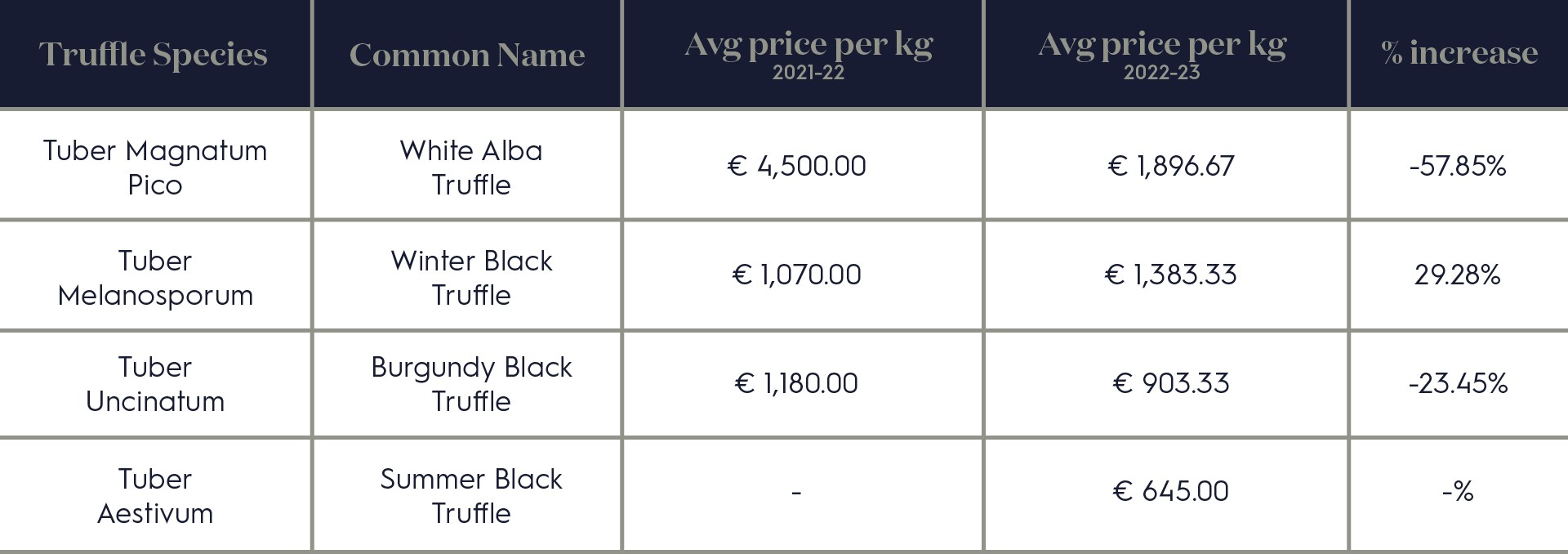Truffles. The name itself conjures images of gourmet meals and luxurious dining experiences. These enigmatic fungi, prized for their intense aroma and unique flavor, are a culinary delicacy enjoyed by gourmands worldwide. But have you ever stopped to wonder, “Why Are Truffles So Expensive?” This seemingly simple question unveils a fascinating journey into the world of scarcity, meticulous cultivation, and high demand that dictates the hefty price tag of these subterranean treasures.
Pound for pound, truffles rank among the most expensive foods on the planet. The primary driver behind this high cost is their inherent scarcity. Truffles are not your average mushroom that sprouts readily in damp conditions. Their growth is a delicate dance with nature, making them seasonal, incredibly difficult to cultivate, and requiring years of patience before a harvest can be yielded. Adding to their exclusivity is their fleeting freshness; truffles have a remarkably short shelf life, further amplifying their value.
 TrufflesTable_2023
TrufflesTable_2023
The Scarcity and Elusive Nature of Truffle Cultivation
Truffles are exceptionally particular about their growing environment. They demand a very specific climate and thrive in symbiotic relationships with the roots of certain trees, predominantly oak. This explains why truffle hotspots are often found within woodlands and oak forests. Even when nature provides the ideal conditions, truffle growth is far from guaranteed. Establishing a truffle orchard is a long-term commitment, often taking up to six years before the first truffles can be harvested. This extended cultivation period represents a significant investment of time, resources, and risk for truffle farmers, contributing to their high market value.
Labor-Intensive Truffle Hunting
The journey of a truffle from the earth to your plate is also marked by the labor-intensive process of hunting. Unlike cultivated mushrooms, wild truffles need to be foraged. This traditional practice relies on skilled truffle hunters and their specially trained dogs (or sometimes pigs). These canine companions possess an exceptional sense of smell, capable of detecting the subtle aroma of truffles buried beneath the soil. Covering enough ground to meet market demand requires numerous hunters and their dogs, adding to the overall cost. Once a truffle is located, it must be carefully unearthed by hand to avoid damage, further emphasizing the meticulous and time-consuming nature of truffle harvesting.
The Race Against Time: Short Shelf Life and Rapid Transportation
The challenges don’t end once the truffle is unearthed. Fresh truffles are highly perishable. Immediately after harvesting, they begin to lose moisture and their precious aroma starts to dissipate. To preserve their quality and deliver them at their peak flavor, rapid transportation is crucial. Truffles must be swiftly transported to customers across the globe, often involving specialized handling and expedited shipping. These logistical complexities and the need for speed contribute significantly to the final price consumers pay.
My two favorite foods are potatoes and truffles. They are diametrically opposed, but together they are for me one of the best combinations possible. For example, truffle and potato salad, truffle with mashed potatoes and poultry in half mourning. – Patrick Ogheard, EHL.
The Truffle Market: A Growing Appetite for Luxury
The demand for truffles has been steadily increasing, further fueling their high prices. Google Trends data reveals a consistent rise in online searches for truffle-related terms since 2013, indicating a growing consumer interest in both truffles and truffle-flavored products. Interestingly, search interest spikes annually around festive seasons, highlighting truffles’ association with celebrations, luxury, and special occasions.
Image source: Google Trends
The global truffle market is a lucrative industry, estimated to be worth billions of dollars and projected to continue growing. This escalating demand has spurred the growth of truffle-centric businesses, from companies specializing in truffle-infused products like oils, salts, and condiments to restaurants that feature truffles prominently on their menus. Today, a significant portion of the world’s truffle supply, around 70%, is cultivated to meet this global appetite.
Truffles: Underground Treasures of the Fungi Kingdom
Adding to their mystique, truffles are a unique type of fungi. They are subterranean mushrooms, belonging to the Tuberaceae family. These edible spores develop underground in a symbiotic relationship with the root systems of specific trees. Unlike common mushrooms that can be cultivated year-round in controlled environments, truffles are seasonal and notoriously difficult to farm, further contributing to their limited availability and premium price.
Climate Change: An Emerging Threat to Truffle Scarcity
The delicate ecosystem required for truffle growth is increasingly threatened by climate change. The loss of woodlands and shifts in climate patterns are negatively impacting wild truffle populations, leading to a significant decrease in their numbers. For example, truffle production in France has dramatically declined since the 19th century, from over 1,000 tonnes per season to a mere 30 tonnes. This vulnerability to environmental changes adds another layer to the scarcity narrative, potentially driving prices even higher in the future. While cultivation efforts are underway, the threat of climate change looms large, casting uncertainty over the long-term availability of these prized fungi.
Truffle Prices in 2024: A Volatile Market
The price of fresh truffles is not fixed; it’s a dynamic figure influenced by a multitude of factors. Supply and demand at any given time, the specific truffle species, and the quality of the individual truffle all play a crucial role in determining its market value. Whether you’re a restaurant sourcing wholesale or a home cook buying retail also affects the price. White truffles from northern Italy, renowned for their intense fragrance, consistently command the highest prices in the truffle world.
Acqualagna, a town in the Le Marche region of Italy, is famous for its annual truffle festival. This event provides a vibrant marketplace where truffles and fresh truffle products are traded, filling the town with the unmistakable aroma of these prized fungi. It’s a testament to the cultural and economic significance of truffles in the region.
The Impact of Truffle Size on Price
The size of a truffle is a significant determinant of its price. Larger truffles are rarer and thus more valuable. They offer a greater proportion of the prized gleba, the flavorful inner part of the truffle, compared to the outer shell, or peridio. Therefore, larger truffles not only fetch a higher price per unit weight but also offer a more intense and indulgent culinary experience.
Choosing the right truffle size depends on your culinary needs. For an intimate dinner, a small white truffle (10-15 grams) might suffice. However, chefs preparing truffle-rich dishes for restaurants may require medium to large truffles to meet their volume needs. Regardless of size, purchasing truffles should involve discernment. Seeking guidance from experienced truffle sellers and exercising caution against fraudulent practices is always advisable.
Determining How Much Truffle to Buy
There’s no universal rule for how much truffle to purchase, but the type and quality are key considerations. White truffles, with their potent aroma and flavor, require only a few grams to season a dish effectively (around 5-10 grams per person). Black truffles, being milder and less expensive, can be used more generously, with recommendations of 10-15 grams per person for a more pronounced flavor.
Understanding Truffle Price Fluctuations
Truffle prices are notoriously volatile, adding to their allure and mystique. While prices are sometimes quoted per kilogram for comparison, it’s crucial to note that truffles are typically sold in hectograms (100 grams) or even smaller increments. Prices can fluctuate dramatically based on availability, size, and other market conditions. Larger truffles, especially those exceeding 50 grams, can experience exponential price increases, reaching hundreds of euros.
Calculating Truffle Costs: Key Factors
Several factors influence the ever-changing prices of truffles. These include the quantity harvested in a given season, overall market demand, the truffle’s preservation status (freshness), its size, and the specific collection period. Purchasing truffles from reputable sellers and understanding the criteria for evaluating truffle quality are essential steps to ensure a satisfactory and authentic truffle experience.
The five main factors that determine the prices of truffles:
- Quantity collected
- Demand
- Conservation status (freshness)
- Size
- Collection period
More Affordable Ways to Indulge in Truffle Flavor
For those seeking a more budget-friendly way to experience the distinctive taste of truffles, truffle-infused products offer an accessible alternative.
Truffle Oils, Truffle Salt, and Truffle Butter
Truffle oils, truffle salt, and truffle butter capture the essence of truffles at a fraction of the cost of fresh ones. Truffle oil is created by infusing olive oil with truffle aroma, while truffle salt and butter incorporate small pieces of truffle to impart their flavor. These products offer a longer shelf life than fresh truffles and can be used sparingly to add a touch of luxury to everyday dishes. When purchasing truffle products, especially truffle oils, it’s important to check labels and ensure they are made with real truffles and not artificial flavorings. A small amount of these potent condiments can elevate pasta, risotto, steak-frites, eggs, and even grilled cheese sandwiches.
Patrick Ogheard’s Guide to the Main Truffle Types
EHL’s Senior Lecturer of Culinary Arts, Patrick Ogheard, provides insights into the four main types of truffles:
1. Tuber melanosporum (Périgord Black Truffle)
- Considered by many to be the best black truffle.
- Originates from southwest France, known as ‘Truffle de Périgord’.
- Season: late November to mid-March.
- Best used fresh, either raw or cooked.
- Garlic enhances its flavor. Rub a garlic clove on a mandolin slicer when preparing truffles.
- Storage: Refrigerate for up to 10 days in a bowl covered with uncooked rice or grapeseed oil (not hermetically sealed as truffles release gas). The rice and oil will absorb the truffle flavor. Eggs stored with truffles will also absorb the aroma through their shells. Can be frozen or sterilized (not hermetically sealed).
- Can be cultivated near trees like chestnut and oak.
- Hunted using dogs, pigs, or flies.
2. Tuber magnatum (Italian White Truffle)
- A white truffle, often regarded as the best and most expensive truffle globally.
- Cannot be cultivated; relies on skilled truffle dogs for foraging.
- Grows underground primarily in the Piedmont region of northern Italy and parts of Greece.
- Season: October to mid-January.
- Storage: Refrigerate for up to one week, not in a closed container. Never freeze.
- Use raw and fresh.
- Pairs well with white meat, seafood, rice, and potatoes.
3. Tuber aestivum (Summer Truffle)
- Also known as “summer truffle”.
- Less flavorful and more affordable. Often used in restaurants simply for the “truffle” name.
- Common during summer, widely available in various restaurants.
- Best used raw, in cool or cold dishes like salads.
- Season: May to August.
- Do not freeze.
4. Tuber uncinatum (Burgundy Truffle)
- Known as “Burgundy Truffle”.
- A hybrid in characteristics, priced lower than Tuber melanosporum but with less flavor than Périgord truffles.
- Season: September to November.
- Grows in shady locations.
- Can be used cooked or raw.
In conclusion, the high price of truffles is a culmination of factors, from their inherent scarcity and challenging cultivation to labor-intensive harvesting, short shelf life, and increasing global demand. These subterranean delicacies represent a unique intersection of nature, culinary artistry, and luxury, making them a sought-after ingredient that justifies their premium cost in the eyes of gourmand around the world.
